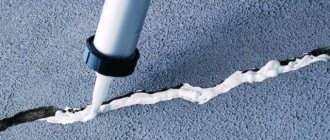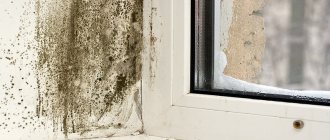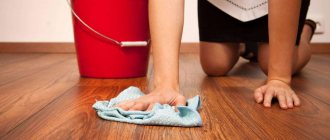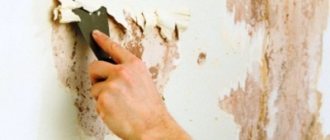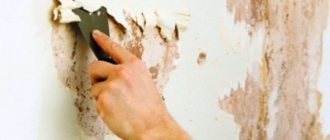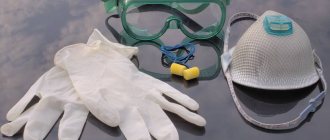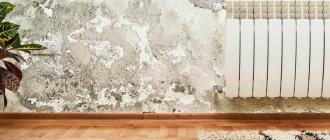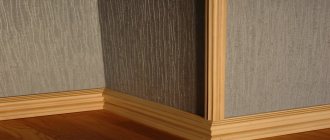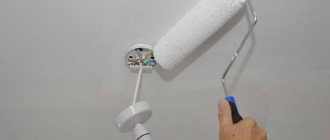Lime whitewash is a material that has not been used in repairs for a long time; it has been replaced by higher quality and modern water-based paint. But previous generations considered slaked lime, and even with the addition of blue for shining whiteness, the best coating for ceilings and sometimes walls. So now, when starting a renovation, we have to think about removing this layer.
Dismantling the old coating and cleaning the surfaces from the finishing is the most tedious, but necessary part of the repair, and lime whitewash must be washed in any case. There is only one reason - lime prevents the adhesion of all finishing materials to the surface.
Whitewash can only be left in one place - on the ceiling, and in the only case - if you are going to install a suspended ceiling or cover it with plasterboard, that is, make a suspended structure. For other purposes it must be removed. You can learn how to wash off whitewash from walls quickly and completely from this article.
Required Tools
First, make sure you have the right tools and equipment. Otherwise, the work process risks becoming more complicated and causing considerable trouble. You will need: a wide construction spatula, a construction scraper, a sanding machine with sanding attachments of different grain sizes, a roller, a sponge, a hard sponge, and a large container for water. Also, do not forget about safety while working. Be sure to wear protective clothing, rubber or fabric gloves, a respirator, and construction glasses.
How to wash lime?
Lime is an alkali, and it is easily neutralized by acid. After most of the whitewash has been washed off, you need to prepare a solution with ordinary table vinegar. Acidified water works well to remove white stains. It is enough to take 100 grams of vinegar per bucket.
Interesting materials:
How is a cow slaughtered? How to block an iPhone through the website? How to block a YouTube channel on TV? How to lock apps using your fingerprint? How to block notifications on Google? How to pick up a parcel from Russian Post without notification? How to remove old paint from walls? How to clean it? How to seal the joint between sewer pipes? How to repair a crack in a floor tile?
Methods for removing whitewash
2. Scraper and wire brush
Quite a labor-intensive method, but no less effective. Be careful: a lot of whitewash and dust will fly in the process, so don't forget your glasses and a respirator. Take a wire brush and go over the surface in a circular motion. If the whitewash sticks tightly in some places, use the sharp corner of a construction scraper.
3. Grinder or vacuum cleaner
The sanding machine will remove the whitewash material to the last residue. Use sanding pads ranging from coarse to fine. As the whitewash layer becomes thinner, move from large to fine grains. A washing vacuum cleaner is also effective in this matter. Use only unnecessary equipment, because after the procedure you will not be able to use a vacuum cleaner.
Unnecessary waste paper can be used for household purposes. Soak the base of the paper with wallpaper glue or paste and apply it to the whitewash, freeing one edge. Wait until the product dries, and then tear off the paper along with the whitewash.
Cook a sticky solution from 1 tbsp. flour and a small amount of warm liquid. Prepare enough water to cover the entire surface and place on the stove. Pour the resulting product into the boiling liquid and mix thoroughly. Wait until the liquid has cooled and the adhesive is ready for use. Apply the solution to a small area and allow it to soak into the whitewash. Next, remove the layer with a scraper. This way the whitewash will come off neatly and not create dust.
6. Soap and soda solution
Folk remedies perfectly remove whitewash, chalk and lime. Take laundry soap, grate it or finely crumble it, and then dissolve it in 5 liters of boiling water. Next, add half a pack of soda ash there. Soak a washcloth in the liquid and run it over the entire surface of the whitewash. The finishing material is easily washed off, especially if you apply the product in a dense layer.
7. Salt concentrate
8. Foam and ammonia solution
The solution is prepared as follows. Dilute 2 tbsp in 3 liters of warm water. ammonia and add 3 caps of diluted bath soap. In another container, mix 0.5 liters of water, 3 tbsp. soda and pour into the first liquid. Stir the resulting product thoroughly and apply it to the whitewash in small areas. Be sure to wear rubber gloves.
Take 5 liters of water and pour half a pack of baking soda into it. Stir the liquid until the white substance is completely dissolved. Soak a foam roller in the product and treat the surface. After 10 minutes, remove the remaining whitewash with a scraper.
10. Ready-made products
Whitewashing is also often used in garden areas. We advise you to read whether it is worth whitewashing trees this spring.
Did you like the article? Then support us, click
:
Source
Dry whitewash removal method
There is also an interesting method for removing whitewash. For this you will need a lot of newspapers.
To remove the whitewash, you will need to use wallpaper glue to glue the newspapers to the walls, leaving a small gap between them and bending one corner of each newspaper. After the glue has dried, it is necessary to dismantle the newspapers. Simply pull the folded corner of each newspaper and remove them along with the whitewash.
In the future, it will also be necessary to prime the walls.
How and with what to wash off lime whitewash from walls and floors after renovation quickly and without streaks
Lime whitewash is a material that has not been used in repairs for a long time; it has been replaced by higher quality and modern water-based paint. But previous generations considered slaked lime, and even with the addition of blue for shining whiteness, the best coating for ceilings and sometimes walls. So now, when starting a renovation, we have to think about removing this layer.
Dismantling the old coating and cleaning the surfaces from the finishing is the most tedious, but necessary part of the repair, and lime whitewash must be washed in any case. There is only one reason - lime prevents the adhesion of all finishing materials to the surface.
Whitewash can only be left in one place - on the ceiling, and in the only case - if you are going to install a suspended ceiling or cover it with plasterboard, that is, make a suspended structure. For other purposes it must be removed. You can learn how to wash off whitewash from walls quickly and completely from this article.
Adviсe
Water will help determine the approximate composition of whitewash on the wall.
You need to apply a few drops to the surface and see what happens next. If the drops are quickly absorbed into the surface, the whitewash is chalk . Drops remain on the surface - lime whitewash.
There is no need to rush and try to cover a large area of the lime layer on the wall at once. By washing off the whitewash in small sections, you can clean the surfaces much faster and, importantly, with better quality.
If, during the process of removing lime from the wall, white spots appear on the floor, potassium permanganate will help remove them . It is enough to dissolve a few granules in two liters of warm water and rinse the dirt with the resulting solution.
Preparing surfaces for repair: removing whitewash
If you can’t do without washing off the lime, let’s learn how to remove this finish quickly, easily, effectively and in different ways. There are several of them. So you can choose the one that suits you.
Important: before you start cleaning whitewashed surfaces, remove all furniture and carpets from the room. If there is nowhere to remove interior items during repairs, wrap them with film, otherwise it will be very difficult to wash everything and clean it from dust later.
Removing whitewash using the “dry” method quickly
This method of cleaning walls from old whitewash is the simplest and fastest, but be prepared for the fact that there will be a lot of dirt and dust after such an event. You will also need special tools.
dream book cat fell from the balcony
To work you will need the following:
Don’t worry, you won’t need everything at once. There are simply several options for dry lime removal from surfaces.
For speed, quality and simplicity, use a sander. Put a coarse sandpaper on it and walk over the desired surfaces with rotational movements.
If you don’t have such a power tool at hand, take a chisel and, applying it at an acute angle to the wall or ceiling, tap it a little with a hammer. After you have made several notches, try to pick up the layer of lime with a spatula and remove it from the surface.
And it also happens that the lime is too old and peels off from the walls and ceiling. In this case, you will not need anything other than a spatula. It will easily scrape off unnecessary coating from surfaces. Then go over the entire area with a wire brush.
After completing any of these procedures, sweep the surfaces with a broom or large soft brush to remove dust. And then go over them with a primer. Now the ceiling or walls are ready for a new finish.
Advice: before you start cleaning surfaces from lime using a dry method, hang a sheet moistened with water on the door leading from this room to other rooms, otherwise the dust will spread throughout the entire home.
"Wet" method of removing lime
All “dry” options for getting rid of old coating, except for a sander, take a lot of effort and time. So if you don't have this useful tool, we recommend trying to remove limescale using water.
For the “wet” method of cleaning surfaces from lime you will need:
Pour more water into a bowl, soak the sponge, wring it out a little and wet the surfaces to be cleaned with it. Moisturize as much as possible because whitewash quickly absorbs moisture.
After this, go over the surfaces again with a soft roller soaked in water, and after 15 minutes, start scraping off the whitewash with a spatula.
This is a very labor-intensive task, so we offer more effective and faster options for removing lime - using special solutions rather than ordinary water. You can find them at any hardware store, or prepare them yourself.
Solution No. 1
Mix 5 liters of water, 50 ml of ammonia and 100 ml of soda solutions (pre-dilute them with water in proportions 1:3), 30 ml of bath foam and 20 ml of 9% vinegar. Heat the mixture to 50 degrees and moisten the surfaces with it.
Solution No. 2
Mix copper sulfate and hydrochloric acid in a 1:1 ratio, apply to old whitewash, leave for 20 minutes.
Solution No. 3
In 10 liters of water, dilute 100 g of baking soda and 60 g of any soap crushed with a grater. Sprinkle this solution liberally on walls or ceilings whitewashed with lime.
Solution No. 4>
In fact, this is the most ordinary paste. It is prepared like this: 40 g of starch is mixed in a liter of water. And then this mixture is gradually added to boiling water. Cook the mixture a little, stirring vigorously until it begins to thicken. Starch can be replaced with flour. Apply paste to the surface covered with lime and let dry.
Solution No. 5
In a bucket of water (10 l), dilute the contents of one bottle of iodine. Apply the composition to the lime - in this way it is easy to remove even the thickest layer.
After using any of these solutions, the whitewash can be easily removed with a spatula.
Advice: it is more convenient to apply all these mixtures not with a sponge, brush or roller, but with a spray gun or spray gun.
With noise, but without dust
There is another way to wash off whitewash from walls, and at the same time it will work quickly and cleanly. But this is only possible if you have an old, unnecessary washing vacuum cleaner.
To do this, fill its tank with one of the solutions described above, or a special one purchased in a store, and wash all surfaces intended for cleaning. If there are no more than 2-3 layers of whitewash on them, this method will be very effective. True, the vacuum cleaner will no longer work.
Remove old whitewash using a spatula or scraper and water
This method will not be as dirty and dusty. To make your task easier, you need to soften the whitewash thoroughly. To do this, you need to saturate the surface with water. Choose the tool that is most convenient and easiest for you to work with. The surface can be wetted using a foam roller or simply sprayed with a spray bottle. If the surface to be treated has a large area, there is no need to try to cover it entirely at once. Divide it into small pieces. The optimal size is meter by meter.
Wet the first sector well, then wet the next one. Now take a scraper and start removing the whitewash from the first section. By the time you process the first sector, the second will already be sufficiently saturated. Next, look at the situation - perhaps the area is too large or, conversely, too small. Make your own adjustments. It is worth moistening the surface generously, but you should not allow streams to flow directly down the walls onto the floor. Also, if you decide to moisten the entire wall at once and do not have time to process it, there is a high probability that the water will simply dry out and the whitewash will harden again. The process will have to be repeated again. By the way, if you determine that the whitewash is chalky, you can simply wash it off with warm water and a sponge.
Elimination of “consequences”
The whitewash was removed from the surfaces, new coatings were applied, and the worst is over. But after renovation, it can be very difficult to remove dirt from the floor and windows without leaving white streaks.
It is not enough to simply wash the floor with water. You will do this over and over again, and after each time, while the surface is wet, it will seem that everything is clean. But as soon as the water dries, new traces of lime will appear. Therefore, you need to act using special methods.
Mopping the floors
It is better to take care of their cleanliness in advance, before the start of repair and preparatory work, so that you don’t have to spend days scrubbing off stains. Cover it with oilcloth or rolls of old wallpaper. It is better to seal the cracks between the baseboard and the flooring with masking tape, otherwise it will be very difficult to clean out dirt and dust from there.
engineered floor board size
But no protection option will provide you with a perfectly clean floor after whitewash removal, especially using a dry method.
Methods for cleaning lime off floors without streaks are dictated by the type of floor covering.
Parquet doesn't like water. Therefore, wring out the rag as hard as possible. And for cleaning use the following solutions :
Important: use only soft rags or sponges to wash parquet, and never hard brushes - this material does not like abrasive materials.
Laminate is also a rather capricious coating that does not tolerate excessive moisture. It is good to clean it from whitewash and dust with an aqueous solution of 9% vinegar (a tablespoon per 5 liters of liquid). A composition with vegetable oil, which was used to wash parquet, is also suitable.
There is another remedy: dissolve half a glass of table salt in a bucket of water. Rinse the laminate with this mixture, and then wipe with a cloth soaked in clean water.
But
linoleum accepts any washing.
But it will be more effective if you add a little turpentine or shavings of laundry soap to ordinary water. For floor coverings in the form of tiles (for example, when renovating a bathroom), safely use special chemical compounds that are sold in construction and hardware stores. None of them will harm the tiles.
Tip: traces of lime can be easily washed off from any surface with a weak solution of potassium permanganate. The exception is parquet, which may leave stains.
General recommendations:
Cleaning the windows
Glass is another problematic surface, which, after procedures such as removing whitewash indoors, is very difficult to get rid of stains.
Important: do not use solutions that contain bleach or soap to clean windows. This will cause the glass to become frosted, which will look unsightly and reduce visibility.
Do not wet the windows with water under any circumstances, otherwise it will take a very long time to remove traces of stains. First, wipe off the dust from the glass with a dry soft cloth.
After this, use special sprayers to clean windows or prepare the solution yourself, following folk recipes.
So, the following composition is perfect for washing windows: a liter of water plus a glass of 9 percent vinegar or a tablespoon of ammonia.
An excellent remedy is with starch. Add a tablespoon to a liter of water and stir vigorously.
Apply these compounds to the windows using a spray bottle and wipe with a dry, clean cloth.
Thanks to the fact that we live in an era of high technology, we have the opportunity to use a special device, the “Kärcher”, for high-quality cleaning of windows from dirt. It bears the name of the German company of the same name, which produces household appliances. This miracle device will easily put your windows in order after being dirty with lime.
You can handle both old whitewash and cleaning after renovation, if you know how to do it correctly. In addition, there are many visual videos of these processes. Choose a method that is convenient for you, and go ahead! The main thing is to remember that construction dust is very dangerous for the human respiratory system, so protect your nose and mouth with a respirator or a cotton-gauze bandage soaked in water.
Source
6. Remove old whitewash from the ceiling using paste
This little trick will help you complete the task not only much faster, but also with the least damage to the room. We only need a package of the cheapest wallpaper glue or regular paste. The mixture is prepared as follows:
After complete drying, the resulting paste is ready for further use. It must be applied to the ceiling using a roller. Try to distribute the mixture evenly. Now you need to wait 10 minutes to let the paste dry. Then start removing it using a regular spatula. The beauty of this method is that the whitewash will not crumble into small flakes and scatter throughout the room, but due to the denser adhesive base, it will fall off in layers. Cleaning up after this will be much easier. And if you use a special scraper with a tray, or attach a regular plastic scoop to a spatula, then contamination can be completely minimized.
How to remove lime from walls without problems
How to remove old lime from walls? If it is necessary to glue wallpaper, putty on surfaces or tiling in a room, the work begins with removing the whitewash on them.
Lime whitewash holds any finishing materials well, but their adhesion occurs only with its last layer. Because of this, after finishing the wall with putty or other material, the finishing lime layer becomes heavy and begins to fall off the surface, which raises a natural question: how to remove lime from the walls.
Safety regulations
When removing whitewash from walls, the following safety precautions must be observed:
It is mandatory to use personal protective equipment.- You should not experiment with solvents that are not intended for whitewash removal. Reckless and unjustified use of serious chemicals can lead to unpleasant consequences - stains on the walls, the formation of toxic fumes in the room, etc.
- Using a grinding machine is only possible after reading the instructions for the device and following all precautions.
- The floor should not be wet or slippery.
How to remove whitewash
Methods for removing lime from walls can be:
Before cleaning the wall from lime in any way, you need to prepare protective accessories:
How to quickly remove whitewash with a spatula
The most popular way to remove a layer of lime from walls or ceilings with your own hands remains mechanical, using a spatula. This is a very labor-intensive process, but quite effective; it is especially good for rooms with very large layers of whitewash.
To work you will need:
Process instructions:
Tip: If the layer of whitewash is too thick, the procedure should be repeated several times so that all the lime is well saturated with water and can easily be troweled.
How to remove whitewash with a sander
How to remove lime from walls in another way? A grinder is used for this. The process is less time-consuming and labor-intensive than the previous one, but it produces a lot of dust.
Advice: When planning a major renovation of a room, if there is no furniture in it, preference should be given to this method, using a grinding machine to clean the surface.
When performing work you must:
How to wash off whitewash with soapy water
Other options for quickly removing lime from walls are wet methods. One of them is the use of soap solution.
You will need to prepare in advance:
The further process is as follows:
Tip: For ease of work, you should use washing powder or liquid soap.
How to remove lime with paste
A very safe and fairly clean option for removing whitewash from walls or ceilings is to use a paste.
To work you will need:
Before finishing the wall with lime paste, it needs to be prepared.
Advice: The composition should be applied as evenly as possible. The evenness of the whitewash layer’s impregnation with the solution affects the final result of the process.
How to wash whitewash with acid solutions
If the above methods fail to wash off the whitewash, and it is known that laying tiles on a lime wall is impossible, acid solutions are used. The method is practically safe for humans; if precautions are taken, the very weak solutions used in it will not have any harmful effects on health.
how to putty clay walls under wallpaper
To carry out the work you will need to purchase and prepare:
The solution is prepared in such a way that the acid makes up 3% of its total mass.
Tip: When diluting the composition, you should pour water into the container, and only after that the acid, to avoid evaporation.
After application with a brush, the whitewash, saturated with the solution, begins to become covered with bubbles, after which the coating can be easily removed with a spatula. The surface is washed again with clean water.
If you don’t have the time and desire to remove whitewash using previous methods, you can purchase ready-made solutions that act like a paste on the lime coating: they bind layers of lime, and after drying, one movement with a spatula is enough to remove them from the surface, but the price will be slightly higher. In addition, an additional convenience is the special structure of the composition, which indicates when you can start removing the glued whitewash by changing its color.
The video in this article shows the most popular methods of removing lime from walls.
The process of cleaning walls from whitewash: stages
The procedure for cleaning walls from lime includes several steps.
The first step is to prepare for cleaning work. To do this, the room is completely cleared of furniture, the chandelier is removed, the equipment is removed, and the floor covering is covered with a thick layer of newspaper or polyethylene. The less polluted, the less to clean.
Next, they change clothes, change shoes, put on protective equipment, bring tools, and put them in working condition.
They start from the upper sections of the wall, since if they clean in a different order, everything will be in vain: a layer of whitewash will fly from top to bottom and stick again to the treated surface.
Sometimes it takes several passes to wash off the lime properly.
It doesn’t matter how to remove lime from all walls before wallpapering; it is important that the base is completely dry.
Next, the walls are left to dry, or the room is left closed to allow dust particles to settle.
How to quickly remove an old layer?
There are several options for removing whitewash from walls. In terms of simplicity of execution, mechanical ones lead. In its pure form, dry coating removal is accompanied by a large amount of dust.
Sander
Using a sanding machine is the fastest way to remove whitewash from walls. The disadvantage of this method is the formation of dust and dirt in large quantities.
Procedure:
Putty knife
Cleaning walls from whitewash using a spatula allows even a non-specialist to carry out the work.
The thicker the layer of coating on the walls, the more labor-intensive the work ahead. The principle of surface treatment is to pry up a layer of chalk or lime and scrape it off onto the floor .
If it is necessary to remove the whitewash completely, areas that are not easily removed the first time can be further treated with sandpaper or a small scraper.
If the whitewash layer is very thick, then you can first tap the walls with a hammer so that some of it comes off and crumbles.
Spray
To ensure that there is less dust during the whitewash removal process and that the layer comes off in large pieces, it is advisable to moisten the surface . In this case, the process of cleaning the walls will move much faster.
You can moisten the whitewash in any way that seems most convenient. Most often, a bucket of water and a wide brush or spray bottle are used for these purposes.
Procedure:
This video will show you how to quickly and dust-free remove whitewash from walls and ceilings:
Washing vacuum cleaner
A washing vacuum cleaner will help remove whitewash from the walls. The device is set to washing mode and the water in the tank is replaced as necessary. The advantages of this method are dust-free removal , the disadvantage is that there is a chance of ruining your household assistant.
Paste
Using paste is one of the popular folk methods. To prepare the composition you will need starch and water.
Component proportions:
Preparation of paste:
Newsprint
The so-called “glue method” using unnecessary newspapers will help in the difficult job of removing whitewash.
Procedure:
Preparation
Regardless of the means used to whitewash, preparation is required before removing it. Since the upcoming work is accompanied by the formation of a large amount of dust and dirt, it is necessary:
Remove as many furnishings as possible from the room. It is especially important to remove upholstered furniture.- Those pieces of furniture that will remain in the room during repair work should be well covered with polyethylene film. Fabric covers are not suitable for these purposes.
- Prepare a stepladder, the height of which will allow the worker to reach the top of the wall.
- You need to prepare tools for work in advance (their list depends on the approach to cleaning the walls).
- Place a wet rag on the threshold of the room being repaired.
- It is important to ensure that the room is isolated from other rooms. This is necessary so as not to spread whitewash throughout the house. In addition to closing the door tightly, you should fill the cracks with foam rubber or seal them with tape.
- If you need to protect the floor from whitewashing, it is best to use cellophane. Newspapers are not effective for such purposes, as they have low strength, and upon contact with water they tear, allowing dirt to pass through.
Before starting work, it is necessary to take care of personal protection - clothing and headgear for repairs, as well as a respirator and safety glasses.
Stripping solutions
In order to avoid the formation of dust when removing the layer covering the walls, special solutions are used. You can make them yourself or buy them in a store. As a result of their reaction with whitewash substances, the layer that needs to be removed softens and comes off without effort.
Homemade
Homemade solutions are not only very easy to prepare, but it also saves money, since all the necessary components are not expensive and are always on hand.
To wash off lime
If the walls were treated with lime, you will need the following preparations:
Procedure:
To remove chalk
In situations where the walls were whitewashed with chalk, the following components will be needed for the solution:
Procedure:
Purchased
In addition to self-prepared washes, you can use purchased professional formulations. You can purchase them in construction stores or order them online, even with delivery.
Examples of effective washes:
The average price is from 600 rubles. for a volume of 5 liters.
If the thickness of the whitewash layer is large, then before applying special agents, the walls must be treated by cleaning, for example, by grinding with a machine or with a spatula.
To rinse or not to rinse and why?
Of course, each of us will be looking for a way to avoid having to do extra work, especially considering that removing old whitewash is a very messy process. Indeed, there are situations when to do this at all :
Now let’s look at cases when it is imperative to wash off old whitewash
A little trick that will help determine the approximate composition of the whitewash - you need to apply a couple of small drops of water to the surface. If they are absorbed, then the main component is chalk. If they remain or begin to drain a little, it means the whitewash is lime.
How to whitewash a ceiling correctly
The most correct way to whiten a ceiling surface is to use a fairly liquid solution that penetrates well into microcracks and pores
This method remains more labor-intensive and requires care and attention, since missed areas on the ceiling will instantly be highlighted after drying
Chalk or lime is applied in at least two layers
How to dilute whitewash for the ceiling
There are two ways to whitewash a ceiling slab, either well or quickly. Usually they recommend at least 2 kg of slaked lime per 5 liters of water. The result is a very thick paste-like mixture, to which 30 g of laundry soap and the same amount of stationery silicate glue are added. The mass is ground to the state of liquid kefir. In order to whiten with such a mixture, serious physical effort is required, but the result is worth it.
The whitewashing process is as follows:
- The ceiling is generously moistened and soaked with water;
- The liquid lime mass is applied to the ceiling and stretched with a spatula and a stiff brush;
- After 10-15 minutes, the laid mass should be whitened with a lime mortar diluted in half.
Important! The lime “applies” well to the ceiling, but stains remain, so it is important to whitewash it a second time with a liquid composition.
The result is a very uniform, blemish-free, smooth and dense surface. Next time it will be possible to whiten it in 2-3 years.
Mixing should be done 3-4 hours before the start of work
How to whitewash a ceiling with the first layer
If you use a standard mixture of 1.7 kg of lime per 10 liters of water, you will have to whitewash it at least two, or even three times, depending on the quality of the concrete ceiling. Before whitewashing, you need to moisten the ceiling sparingly; there is already a lot of water in the solution itself, and its excess has a detrimental effect on the quality of the work.
The first layer is applied with a roller or brush. Despite the liquid solution, lime also needs to be rubbed into the ceiling, otherwise the first layer will not stick to the concrete. Whitewashing with a pneumatic sprayer or a knitting brush will not work; all the lime will end up on the floor of the room.
I rub lime on old whitewash with a spatula
Stages of washing off paint
Despite the scale of the work, whitewash can be removed quite quickly by following the stages of the work. Repairing, in principle, does not involve a fun pastime, but strictly following the instructions will make the process more comfortable and clean.
Preparation
Preparing the room
The first stage of work involves preparing the room for ceiling repairs. This step is necessary in any case to protect walls, windows and furniture. After the preparatory work, all that remains is to decide how to wash away the old whitewash from the ceiling and begin work.
What to do before removing the chalk layer:
- cover windows, frames, window sills with transparent film;
- remove or cover furniture with film, blankets, rags;
- remove mirrors, remove small interior items (lamps, paintings, chandeliers, books, photos);
- cover the floor with film or newspapers;
- seal the sockets with masking tape or polyethylene;
- cover the walls (bare walls with peeled wallpaper can be left like this);
- turn off the electricity in the room and take care of the light source (bring a flashlight, connect an extension cord from another room, use diode lamps);
- place a wet rag in front of the entrance door to wipe your feet before leaving and close the gap between the door and the floor;
- prepare a stable stepladder with which it is convenient to reach the ceiling;
- prepare ammunition - plastic glasses, a scarf, a respirator or gauze bandage, comfortable work clothes.
To prevent sheets of film from moving apart on furniture and the floor, it is recommended to secure the joints with tape. Furniture can be previously covered with special thick covers. It is better that the protection hides the interior completely, right down to the floor, since dust easily penetrates into any cracks and holes.
Covers will protect furniture from dust
Tools
Required Tools
The choice of how to wash away the whitewash on the ceiling depends on the type of finish and the abundance of stains. The limescale layer or paint can only be removed using a scraper - in a dry way. For deep stains and mold, you will need additional tools and liquids - soap solution, antiseptic, acids, solvents. Methods for combating mold and rust should be studied separately.
| Image | What is it needed for? |
| It is easy to remove layers of whitewash with a scraper |
| Warm water is poured into the container to wet the surface. |
| Needed to moisturize whitewashed surfaces |
| Removes dirt and chalky layers |
| Necessary for atomizing moisture |
| Easily applies soap solution and moisture to large areas |
| Convenient for collecting pieces of whitewash when working with a spatula |
| Useful for washing cleaned surfaces |
The chalky layer is washed off with plain warm water, but in some cases you will need a prepared solution for rinsing. In case of difficult whitewash removal, it is recommended to prepare in advance:
- laundry soap;
- soda;
- flour;
- bubble bath;
- vinegar;
- whiteness;
- iodine;
- salt.
The price of all tools and means is low. Everything you need to process the ceiling can be found in a hardware store, hardware store or at home.
Flushing process
When a preliminary analysis of the work has been carried out, all the necessary tools and methods of protection have been prepared, cleaning should begin. This can be done in two effective ways - wet and dry.
| Method | Instructions |
| Wet the surface and wait for it to dry. Clean off the whitewash with a spatula. If necessary, wet and clean again. Remove any remaining chalk with a damp sponge. |
| By “tapping” the hollow layers of whitewash with the back of a spatula and carefully removing pieces of paint with a blade, you need to clean the surface of the ceiling. For convenience, you can replace the wide blade with a narrow one. Upon completion of the procedure, wash the dusty surface with a damp cloth or sponge. |
Completion
After you have more or less succeeded in washing off the whitewash on the ceiling, you need to evaluate the work, work on particularly difficult areas and wash the surface with plain water. Sweep up the settled dust and pieces of whitewash, collect in one place and throw away. When the surface has dried, you can begin repairs - new whitewashing, wallpapering or insulating boards, painting.
Ceiling cleared of whitewash
How to clean it yourself: review of products
Flush with water
If the whitewash layer is relatively thin, it can be washed off with water.
- Dissolve 1 kg of salt in 10 liters of hot water.
- Allow the solution to cool to 45 degrees.
- Soak a sponge in the solution and wipe the ceiling until the chalk is completely washed off from the base. You should work carefully so that the drops do not start flowing down your hand or dripping onto the floor, head or clothes.
- The ceiling is washed off with a sponge, removing layer by layer until a clean surface appears. Change the water as often as possible, and rinse the sponge in clean running water.
How to remove using paper?
Stages of work:
- Prepare an adhesive solution for wallpaper (you can use paste).
- Using a wide roller, the solution is evenly applied to the ceiling surface in a thick layer.
- Old wallpaper, newspapers or paper are soaked in an adhesive solution, then pasted onto the prepared surface until dry.
- When the wallpaper or newspapers are dry, they are removed from the ceiling. Along with the paper, the old whitewash is also removed. If the coating still remains in some areas, it is scraped off with a spatula.
Attention: For ease of work, the edges of wallpaper or newspapers are left unattached to make them easier to remove.
Removal with paste and wallpaper glue without dust and dirt
Stages of removing whitewash with wallpaper glue or paste:
- Prepare wallpaper glue or paste. To prepare the latter you will need flour or starch and water. Flour or starch is dissolved in 1 liter of warm water, slowly poured into boiling water, stirring until completely dissolved (the volume of boiling water is approximately 3 liters).
- Cover the ceiling thickly with glue or paste, let it dry a little (not until completely dry), but the coating layer should be thick.
- Remove the wet whitewash layer with a spatula.
Quickly using a sander
Removing old coating with a sander is a simple, quick way. When working with a sander, you should take care of safety equipment
Special solutions
- Concentrated detergent for cleaning after renovation work ALFA-20 copes well with lime and chalk whitewash. To work, the product is diluted with water in a ratio of 1/20 and applied to the surface with a brush, roller or spray. The solution is left for a few minutes and then the coating is removed with a spatula.
- Metylan wallpaper remover is diluted with water in a ratio of 1/10. It copes well with lime and chalk compounds, its operating principle is the same.
- A special composition for removing whitewash - Probel - is dissolved in water and then washed off with a sponge. The remaining coating is removed with a spatula.
- Cleaning concentrate from Probel is also suitable for washing off old coating. The composition is diluted with water in a ratio of 1/20 and applied to the surface. The ceiling is cleaned with a spatula.
- To do this, dissolve 2 tablespoons of ammonia in 3 liters of water, add a soda solution, 2 caps of bath foam, and 1 tablespoon of vinegar.
- To prepare a soda solution, dilute 1 part soda in 3 parts water.
- Pour 2 liters of boiling water into the finished composition and cool to a temperature of 50 degrees.
- Apply to the surface and then remove the coating with a spatula.
When is it necessary to wash off whitewash?
Contents of the material
This is a question that beginners often ask after scraping a small area of whitewash from the ceiling and getting quite dirty in the process. But is it really necessary to completely remove the old coating when preparing the ceiling for final finishing?
Experienced repair professionals advise cleaning whitewash to the ground in several cases:
- before new whitewashing, if the old coating is peeling off or there are stains, stains and streaks on it;
- before painting with interior paints;
- when preparing the ceiling for wallpapering;
- if it is necessary to repair joints - plaster, putty, seal cracks;
- before attaching sound and heat insulating boards to glue.
In other cases, it is enough to remove the flaking areas of whitewash using a dry method (with a spatula or sander), and then sweep the ceiling with a dry brush. This way you can prepare the ceiling for the installation of suspended ceilings made of plasterboard, panels or aluminum slats, as well as for the installation of a suspended ceiling.
Wet cleaning
In cases where there is no sanding machine, you can clean the whitewashed ceiling by simply washing it off.
The procedure for how to properly wash off whitewash from the ceiling:
- To wet the ceiling, use warm water and a foam sponge. This procedure can also be carried out using a brush or spray bottle, spraying water from a distance of 60-70 cm to the ceiling.
- To prepare the solution for washing, in addition to warm water, use 3 tablespoons of washing powder and 5 tablespoons of soda. Powder and soda can be replaced by ordinary table salt. To apply the finished solution to the base, use a textile roller. Difficult and hard-to-reach areas are treated with a paint brush.
- It should be borne in mind that the process of absorption of water into whitewash occurs very quickly. To quickly remove chalk from the ceiling, as a rule, soaking the whitewash several times helps: this will give the old finish a chance to spread out well. To avoid excess dirt, place a prepared container under the whitewash to be removed.
- Next, a short pause is made until the whitewash softens and becomes pliable.
- A durable spatula or scraper is used as a tool for cleaning the surface. It is necessary to initially prepare for the fact that this method will not solve the problem of how to quickly wash off the whitewash from the ceiling. In this case, you will have to work hard. Once the old layer has been peeled off, the clean surface is treated with sanding paper. Next, a layer of primer is applied.
- All surface defects discovered during grinding must be eliminated using a repair mixture. The most convenient way to do this is to use gypsum putty or plaster. Every hardware store has a large selection of similar materials.
As you wet the ceiling, it is recommended to soak it in small areas, immediately removing the soaked layer. This will make it possible to achieve the maximum goal of how to quickly wash off chalk from the ceiling. In this case, the wetted whitewash will not have time to dry. If the whitewash layer is small, then the procedure can be carried out by simply washing it out. To do this, you will need a stiff brush or rag. However, in this case, the load on the worker’s muscles increases noticeably, since rubbing the surface with a brush requires considerable effort. The process is characterized by a fairly large amount of water that ends up on clothes and the floor.
Preparatory work: tools and materials
Before washing off the whitewash from the ceiling, you need to prepare:
- wide sheets of polyethylene film;
- an ordinary medical mask or respirator;
- special glasses for eye protection;
- headdress (scarf, comfortable cap);
- water spray or vacuum cleaner;
- spatulas of different widths;
- comfortable clothing that does not restrict movement, preferably with long sleeves;
- rubberized household gloves;
- the right amount of hot or warm water;
- stable scaffolding (you can take a table);
- large household sponges, gauze (for washing the ceiling).
Before removing whitewash from the ceiling in a room, it is advisable to remove all furniture from it. The work of cleaning the ceiling from whitewash involves a lot of dirt and dust, so if it is impossible to remove all large interior items, they must be covered with film as thoroughly as possible. It is possible to lay cardboard or large sheets of newspaper on top, and securely secure the film with adhesive tape.
Otherwise, in addition to cleaning the room, you will have to clean all furniture surfaces. Therefore, before removing the whitewash from the ceiling, you need to think through and solve this problem in advance.
Useful information: “How to whitewash a ceiling using old whitewash”
The floor in the room is covered with film and paper. It is necessary to keep a damp cloth at the entrance to the room to wipe the shoes when the master leaves the room, otherwise all the dirt will spread throughout the apartment.
